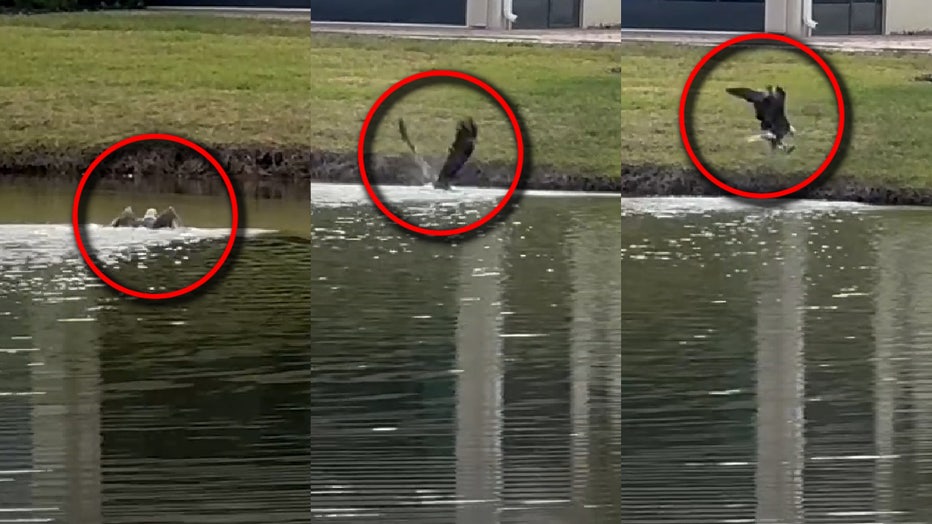VIDEO: Florida Bald eagle does fast breaststroke across the water with fish in talons
Florida Bald eagle rows across pond with fish in talons
A Bald eagle in Florida was caught seemingly rowing -- or flying -- across a pond shortly after catching a fish. Kathy M, of Viera, Florida, was alerted by her neighbors to the eagle in the water. She went outside to watch and began recording. She said at first she wasn't sure if the eagle was hurt or perhaps caught too heavy of a fish, but that it appeared to be doing the breaststroke across the water.
MELBOURNE, Fla. - Bald eagles are majestic, flying through the air on any given day or seated high atop their nests. But, one Florida neighborhood captured a wild encounter they had not seen before – a bald eagle appearing to do the "breaststroke" across the water with a fish deep in its talons.
Kathy McKee, who lives in Veira, Florida, which is about 45 minutes southeast of Orlando, said she and her neighbors love to watch the wildlife in their neighborhood, especially in a pond in their backyard.
On Wednesday, her neighbor reportedly saw an eagle appearing to fight in the air. Over what? A fish. But by the time McKee came outside to watch, the eagle was in the water, feveriously swimming towards the shoreline.
"Whenever we see wildlife, we call one another and say, ‘hey, you got to come. You got to come look.’ So it was right behind our house," she said.
"The eagle dropped the fish and so when we came outside, the eagle was in the water in the middle of the pond. And our first thought was – is because it kept trying to fly out, several times it tried to fly out of the water – and we thought, 'gosh, you know, maybe it's hurt. Maybe it (has a) hurt wing or something. And then it started doing the breaststroke and we were just all like, ‘that is amazing,' she said.

The eagle makes it back to shore where it appears to have a small fish in its talons. It stands over the fish for several moments before the video ends. McKee said moments later, it took off and flew away.
"I figured it was going to just sit there and eat it, eat its prey. But right after I shut my camera off, it flew off would have been really cool to get on film because it's so majestic, so beautiful," she said.
FOX 35 spoke with Tyler Beck, a raptor expert with the Florida Fish and Wildlife Conservation Commission. He said it's possible that the fish was too heavy for the bird, his feathers got too wet, or misjudged.
"I wouldn't say it's something that the bird wants to do, it doesn't want to put itself in that position. But it's not uncommon. We see videos of this, you know, probably a couple times a year popping out of a bird doing this," he said.
He said water is an important resource for bald eagles, especially in Florida, because it's where they get most of their food.
"Eagles are really strong birds – really, really strong breast muscles. So they can really, uh, push through the water pretty, pretty well. Once they get to land, they can dry off pretty quickly and fly off," he said.
Beck watched the video – and here was his immediate reaction.
"I had a couple things going through my head when I saw that. The first is that it was it was moving pretty quickly across the water. And that's really good to see that. You know, it wasn't struggling. It was it was going to get to shore," he said.
At the eagle left the water with the fish in its talons, Beck seems surprised that the fish wasn't larger.
"It's basically flying across the water. It's doing the same flapping motion that you would do," he said.
"It doesn't look like a real big fish. It should have been able to fly away with that, but it may have just misjudged the surface of the water and got more wet, or the fish was deeper than it thought," he theorized.
How many bald eagles live in Florida?
Tyler Beck, FWC raptor expert, said it's tough to know exactly how many bald eagles live in Florida. However, he said their numbers have continued to improve, which is good news and means there are more bald eagles out there.
According to the FWC's website, Florida has one of the "densest concentrations of nesting bald eagles" in the lower United States with 1,500 estimated nesting pairs. What's not known is how recent that figure is.
Once listed as endangered, it was removed from the list in 2007 and 2008. However, they are still protected which makes it illegal to bother, harm, hurt, or kill them.
How to safely view bald eagles?
The FWC has a handful of safety tips for bird watchers, photographers, or enthusiasts to remember should they see a bald eagle:
- Use binoculars or spotting scope to watch them
- Do not stand directly under a nest. Stay at least 330 feet away.
- If watching from the side of the road, stay inside your vehicle. Cars can serve as "very effective bird blinds," the FWC says
- Do not make loud or sudden noises. Do not yell, slam car doors, or honk the horn.
- Never try to make an eagle stand up in their nest or fly.
- Give them the space they need.
Eagles typically return to their nests in the fall to begin building their nest or repairing it. The breeding season can last until late April or May when the young birds are able to fly. Eggs are usually laid in December or January and the babies can hatch around 35 days.
Visit the FWC's website to learn more about bald eagles.

